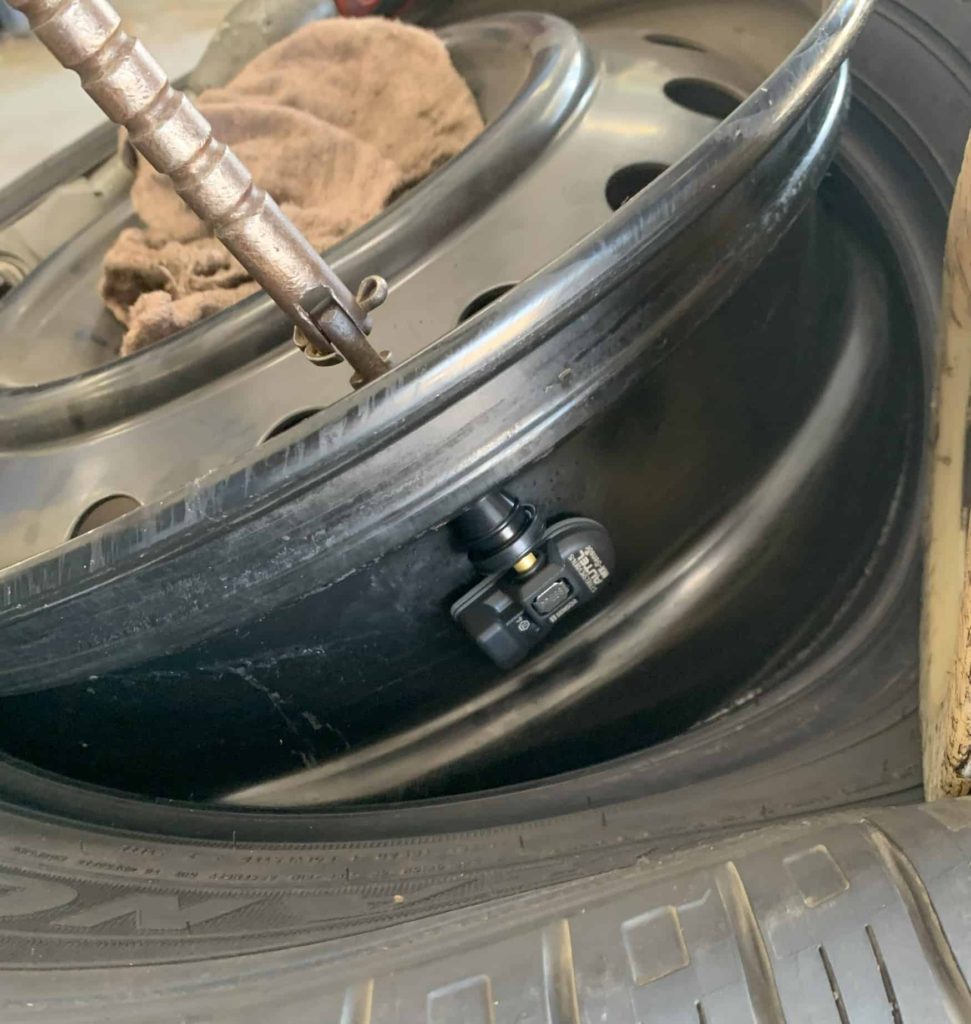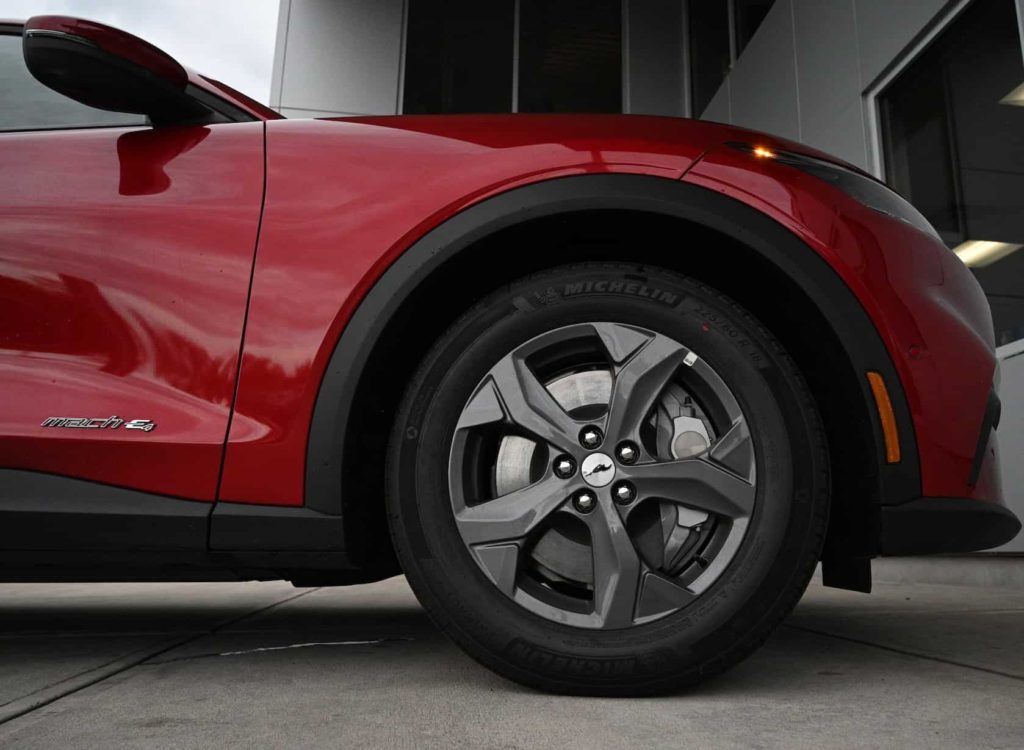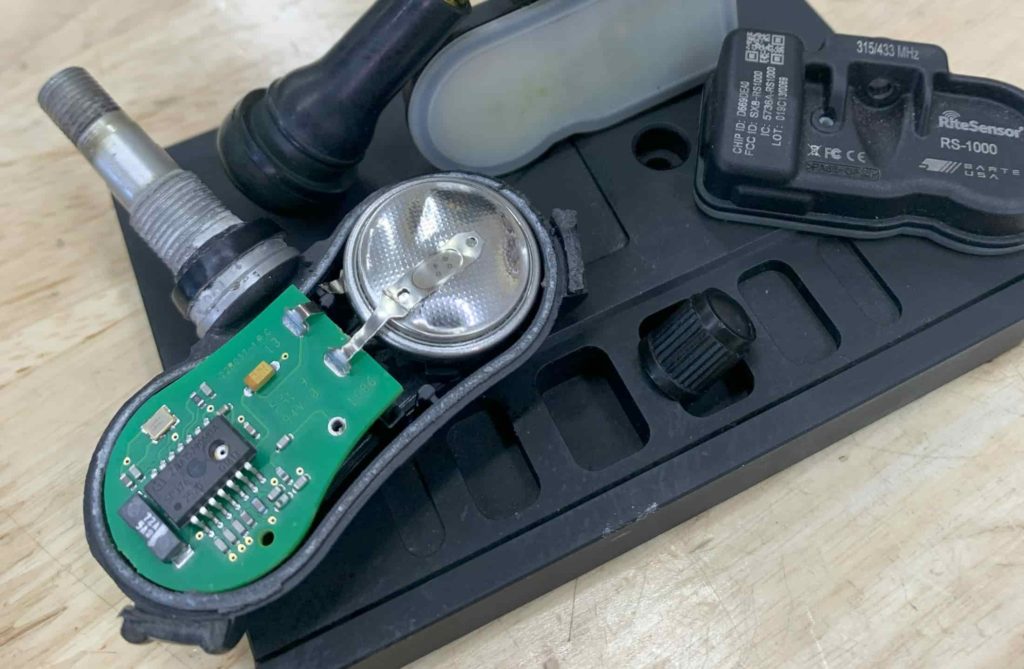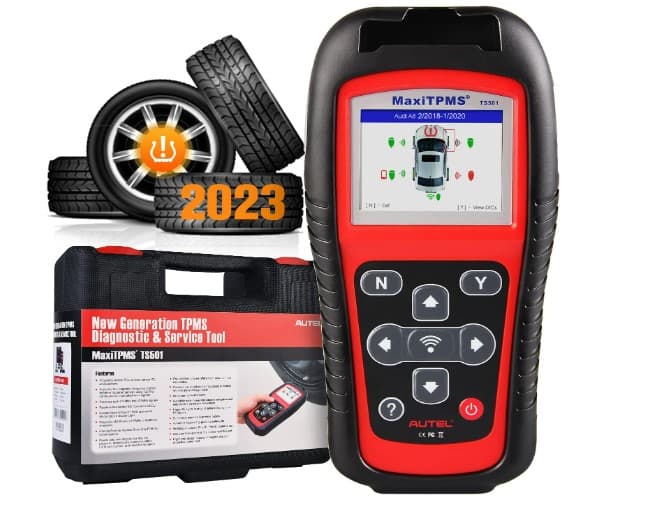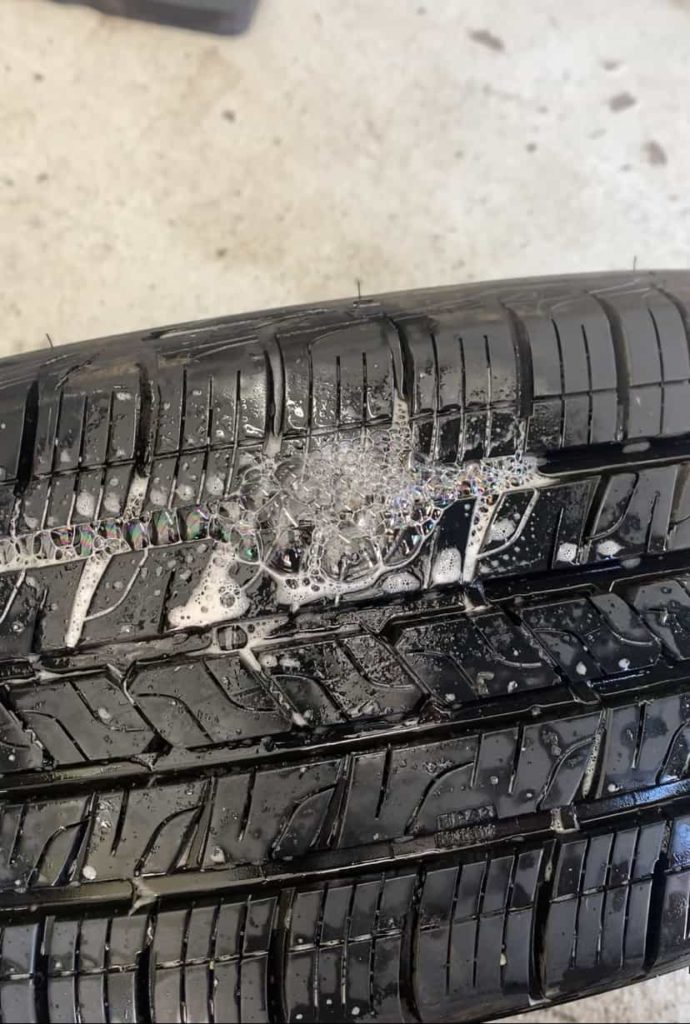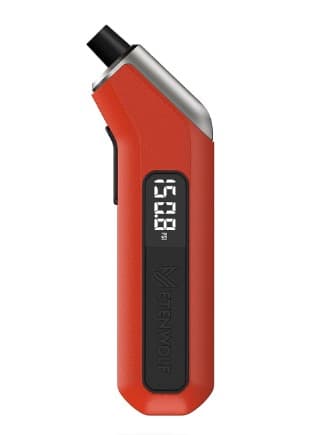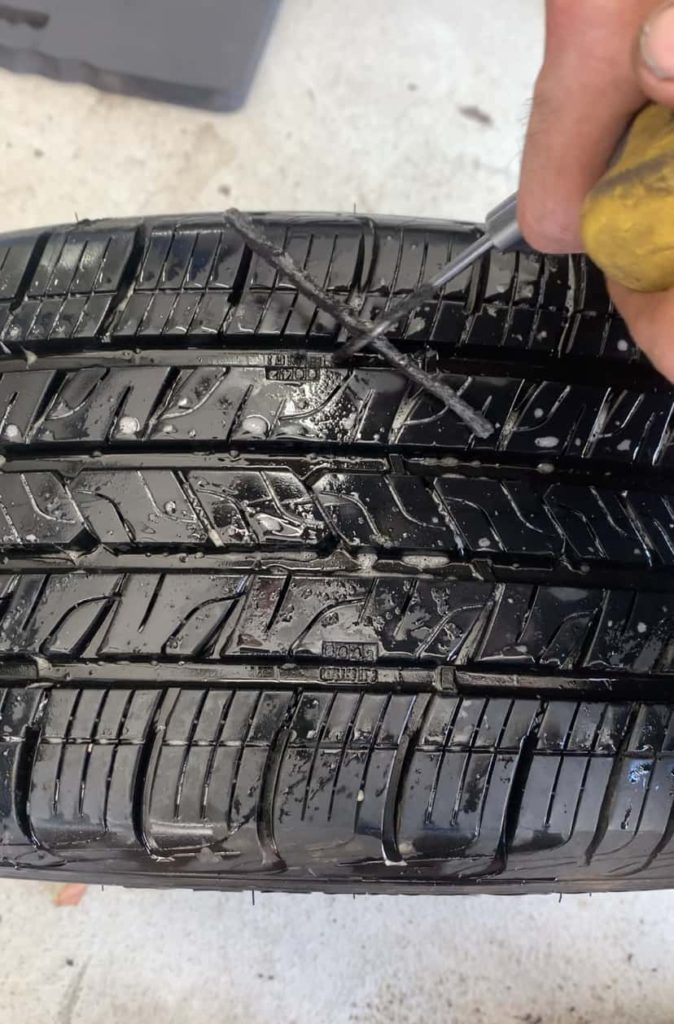What is the Ford Mustang Mach-E Tire Pressure System?
The Ford Mustang Mach-E Tire Pressure Monitoring System (TPMS) is a cohesive unit composed of three essential parts. These work in unison to signal the driver when tire maintenance is needed. The system incorporates tire pressure sensors, a specialized TPMS receiving unit, and the car’s main computer, also known as the ECU or ECM.
How Does the Ford Mustang Mach-E TPMS Work?
TPMS Sensors: Located at each tire’s valve stem base, these sensors kick in to monitor both pressure and temperature once the vehicle reaches a speed over 20 mph. Encased in a small plastic container, each sensor features its own circuit board and functions through a battery-fueled transmitter.
Wireless Frequency-Based Data Communication: When the Mustang Mach-E is in motion or the tire conditions alter, the data collected by sensors is sent wirelessly. They employ either 315 MHz or 433 MHz frequencies for data transmission via Radio Frequency (RF).
In-Car TPMS Receiver: Inside the Mustang Mach-E, a secondary microcomputer or circuit board is designed to pick up the wireless signals dispatched by the sensors. This receiver then funnels the aggregated data to the primary computer or ECU for further assessment.
Mustang Mach-E ECU: The Electronic Control Unit (ECU) of the Mach-E processes incoming tire-related data and stacks it up against Ford’s standard benchmark pressure values. If the tire pressure falls 15-20% or more below these, a warning is set off.
Dashboard Low-Pressure Indicators: When tire pressure dips below the safe range, as determined by the ECU, a yellow warning light shaped like an exclamation mark lights up on the dashboard.
How to Reset the Ford Mustang Mach-E TPMS?
Park: Park the Mustang Mach-E on level ground.
Measure and Adjust Pressure: Check and adjust the air pressure in all tires and set them to the recommended cold pressures.
Drive: Drive the Ford Mustang Mach-E for a few minutes, ensuring you exceed a speed of 20 mph.
How to Retrain the Ford Mustang Mach-E Tire Pressure Sensors
Shut Off Power: Turn the power of Mustang Mach-E Off.
Power On: Turn the power of the Mach-E On.
Cycle Hazard Lights: Press the hazard light button on then off 3 times for a total of 6 button presses. On-Off, On-Off, On-Off.
Tire Pressure Sensor Status: If steps 1-3 are correctly executed, you’ll hear a single horn honk and a display alert will confirm that you’re in “RESET MODE.”
Left Front Tire: Unscrew the valve cap from the tire on the driver’s side front (front left tire) .
Deflate Left Front Tire: Gently push in the valve core and start releasing air, until you hear the horn beep once.
Right Front Tire: Transition to the front right tire (front passenger tire), remove the valve cap, and start releasing air until a horn honk is heard.
Right Rear Tire: Move to the rear tire on the passenger side, remove its valve cap, and deflate it until a horn honk signals completion.
Left Rear Tire: Lastly, navigate to the driver’s side rear tire, remove the valve cap, and release air until a horn honk is heard.
Finalize Training: A “Training Complete” alert will manifest on your information display screen if all actions are properly carried out.
Reinflate Tires to Specified Levels: Pump the tires back up to their advised pressure.
Validate by Driving: Drive the Mach-E for at least a few minutes, ensuring you surpass a speed of 20 mph.
Tips on Retraining the Tire Pressure Sensors
💡 In the absence of a horn sound following the completion of the third step, start the entire process over. (Cycle the power several times, drive the vehicle, and then make another attempt.)
💡 Only follow the tire pressure sensor re-training sequence in the specified order.
💡 If two beeps are heard as you turn off the power, go through the entire reset process again.
How to Check Mustang Mach-E Current Tire Pressure
Select the SETTINGS button on the information display screen
Select TIRE PRESSURE from the apps men.
2023 Ford Mustang Mach-E Tire Pressures
TIRE SIZE | FRONT PSI | REAR PSI |
245/45R20 | 39 | 39 |
Different Ford Mustang Mach-E Tire Pressure Warning Messages
"TIRE PRESSURE LOW"
This alert serves as a signal that a minimum of one tire requires inflation to meet the suggested pressure guidelines.
'TIRE PRESSURE MONITOR FAULT"
This warning signifies a malfunction or irregularity in the tire pressure monitoring system itself, triggering the yellow exclamation mark tire light to flash.
"TIRE PRESSURE SENSOR FAULT"
This message means that one or more tire pressure sensors have lost communication with the TPMS receiver unit.
What Will Trigger the ford Mustang Mach-E Low Tire Pressure Light?
Tires lacking adequate air pressure
Overpressurized tires
Tires with air leaks
Wheel without sensor (for instance, when using a spare)
Aged or malfunctioning TPMS battery
Inoperative TPMS receiving unit or ECU
Nearby electronic gadgets or Ford cars causing disruptions
Alterations in weather or altitude
Surpassing the vehicle’s load limit
Installation of tire chains
Extreme window tints
Ford Mustang Mach-E Tire Pressure Sensor Batteries
Essentially, a tire pressure sensor is a tiny electronic board with a transmitter attached to a small battery. Every wheel of a Ford Mustang Mach-E comes with a tire pressure sensor, fueled by a silver-oxide battery (the Mach-E spare tire is an exception and doesn’t have a pressure sensor). This sensor’s electronic circuit board is connected straight to the battery, all inside a plastic case. The way it’s built makes it impossible to simply change or recharge the battery when it depletes; you’re required to replace the full sensor and its valve stem. Generally speaking, these sensors from Ford are designed to last between 5 to 10 years or up to an estimated 100,000-150,000 miles.
Troubleshooting the Ford Mustang Mach-E Low Tire Pressure Light
Occasionally, the tire pressure reset function or the retraining process for your Ford Mustang Mach-E fails to deactivate the tire light. When the light persists, identifying the root cause becomes necessary. Here are five likely scenarios and their respective solutions to help you address the persistent tire light problem.
Solution 1: Is a Tire Leaking or Losing Air Pressure?
The first step when the low tire pressure alert activates is to assess whether any of your tires have an air leak. Perform a visual inspection of each tire and wheel and then follow these three steps:
Avoid depending solely on the onboard tire pressure monitoring system; use a manual pressure gauge on all tires to isolate the underinflated one.
Use a portable inflator or one at a service station to adjust and correct the air pressures in the tires. Verify the pressure readings after inflation.
Drive your Ford Mustang Mach-E at speeds greater than 20 mph for a short duration.
ANSWER: If the low tire pressure indicator deactivates after inflation and a brief drive but then reactivates subsequently—be it seconds, minutes, or days later—you can have near-complete confidence that a leak exists in the specified tire or wheel. To identify exactly where the leak originates on the wheel or tire, refer to solution 6 provided below.
Solution 2: Identifying Weak Batteries or Defective Tire Pressure Sensors
If you believe that one of your tire pressure sensors is failing or not working, you’ll need a TPMS diagnostic tool for further evaluation. I’ve been using Autel TPMS diagnostic tools for an extended period and vouch for their quality. To identify which of your tire pressure sensors are not functioning as they should, follow these steps:
Plug the TPMS diagnostic instrument into your Ford Mach-E’s OBD2 port.
Place the TPMS tool right by the valve stem on the front wheel on the driver’s side and activate the “Trigger” or “Test” function on the device.
Wait briefly for the tool to respond.
Follow the tire testing order dictated by the tool for the other tires.
ANSWER: Upon concluding the testing sequence for each tire pressure sensor, the TPMS diagnostic tool will generate a comprehensive report on the state of every sensor. If any sensor is non-communicative or has a low or depleted battery, it will need to be substituted with a new unit.
Solution 3: Engaging an Unresponsive Tire Pressure Sensor
On occasion, a Ford Mustang Mach-E tire pressure sensor may cease to function or become unresponsive. To try and reactivate the faulty TPMS sensor, consider the following steps:
Pinpoint the tire with the malfunctioning pressure sensor and let some air out.
Release around 15-20 Psi by pressing the core of the valve stem.
Reinflate the tire to its suggested pressure, adding an extra 5 Psi for good measure. For example, if the tire typically needs 39 Psi, pump it up to 44 Psi.
Take your Mach-E for a 5 minute drive, making sure to exceed 20 Mph.
Once parked, readjust the tire’s pressure to its recommended level.
ANSWER: If you followed the tire pressure retraining guide and it didn’t work, follow this solution and then attempt the tire pressure retraining guide again.
Solution 4: The Mach-E Tire Light is Turning On and Off By Itself
Living in a region with varying overnight or seasonal temperatures probably means you’ve started your car on a cold morning only to find the low tire pressure indicator lit. You may also have noticed that the warning light turns off as the day warms and you continue driving. Though this is typical, it’s not inevitable.
ANSWER: To achieve precise tire pressure readings, it’s crucial to adjust the tire pressures when they are cold. In this context, ‘cold’ means the Ford Mustang Mach-E has been idle for at least three hours or has been driven for under a mile. Adhering to this rule ensures you’re setting your tire pressure accurately.
Solution 5: Finding the Origin of a Tire Leak
If you suspect you have a tire that’s leaking, you can locate the precise source of the air leak. You’ll require a few items: water, soap, a portable tire inflator, and a spray bottle.
Pump up the tire to at least 39 Psi.
Fill your spray bottle with soap and water, making sure to mix the contents thoroughly.
Saturate the fully inflated tire using your water-soap mix.
Scrutinize the soaked tire to spot small air bubbles.
ANSWER: Once you observe bubbles emerging on either the tire or valve stem, you’ve pinpointed the location of the leak. Circle it with chalk to note the location.
How Air Temperature Changes Affect the Ford Mustang Mach-E Tire Pressure
The tire pressure in a Ford Mustang Mach-E is sensitive to changes in air temperature. The science goes like this; a 10-degree Fahrenheit temperature change corresponds to a 1-2 Psi change in tire pressure. For example, if your tire pressure is set to the required 39 Psi on a day that’s 85°F, and the temperature drops overnight to 65°F, this could result in your tire pressure dropping to 35-36 Psi. This drop in pressure can set off the Mach-E low tire pressure warning light.
How to Check Ford Mustang Mach-E Tire Pressure
Quick Look-Over: We advise starting off with a brief walk-around of the EV to visually assess each tire’s condition.
Air Pressure Gauge: Digital tire pressure gauges are best for accuracy and simplicity.
Ideal Tire Conditions: Ensure the tires are cold, meaning the EV hasn’t been driven recently or has traveled less than a mile. This is the only way to get an accurate air pressure measurement.
Take Initial Reading: Remove the tire’s valve cap and apply the pressure gauge to the valve stem for a pressure reading.
Compare to OEM Specs: Compare the reading you took to the recommended pressure set by Ford for the Mach-E.
Make Adjustments: Add or release air as needed to match the OEM specification.
Confirm: Double-check the tire pressure with your gauge after altering the pressure.
Valve Cap: Put the valve cap back on!
Complete: Perform the same procedure for the other 3 remaining tires.
Common Ford Mustang Mach-E Tire Pressure Questions
Is it Safe to Drive the Mustang Mach-E With the Tire Pressure Light On?
When the low tire pressure indicator illuminates, it serves as an alert that something is amiss. This could stem from either inadequate tire pressure or a glitch in the sensor-ECU communication. Operating the Ford Mustang Mach-E with the light on poses a risk if the underlying issue is unknown. We suggest halting your drive as soon as it’s safe and assessing the tire pressures to determine why the warning light is on.
Why is the Mustang Mach-E Tire Light Flashing?
When the tire light blinks it signals that at least one tire pressure sensor is not effectively communicating with the Ford Mustang Mach-E ECU or TPMS receiver module. When this happens, It’s known as a TPMS malfunction. This can happen if you’re driving on a spare tire that doesn’t have a built-in TPMS sensor or if one or more of the sensors have batteries that are either low or completely dead. For troubleshooting this problem, consult Solution 2 above.
Is it Safe to Use Tire Plugs for Tire Puncture Repair?
Having spent many years in the automotive repair industry, I can vouch for the effectiveness of tire plugs for fixing punctures on the tire tread. Tire plugs are robust and can endure for as long as the tire does. It’s essential to note that they’re not suitable for tires with diminished tread or for use on the tire sidewall.
Can Using Tire Sealants Harm Tire Pressure Sensors?
Tire sealants may provide a quick fix but can result in long-term costs. They can adversely affect the tire pressure sensors, breaking them, and contribute to tire imbalance.
Everything in this article is applicable to all Ford Mustang Mach-E models and versions including the Ford Mustang Mach-E Select, Premium, California Route 1, and GT.
Please note that this blog post contains Amazon affiliate links. This means that if you make a purchase through one of these links, we at TPMSRESET.COM may earn a small commission at no extra cost to you. We only recommend products that we personally use and believe in. Thank you for supporting us.

